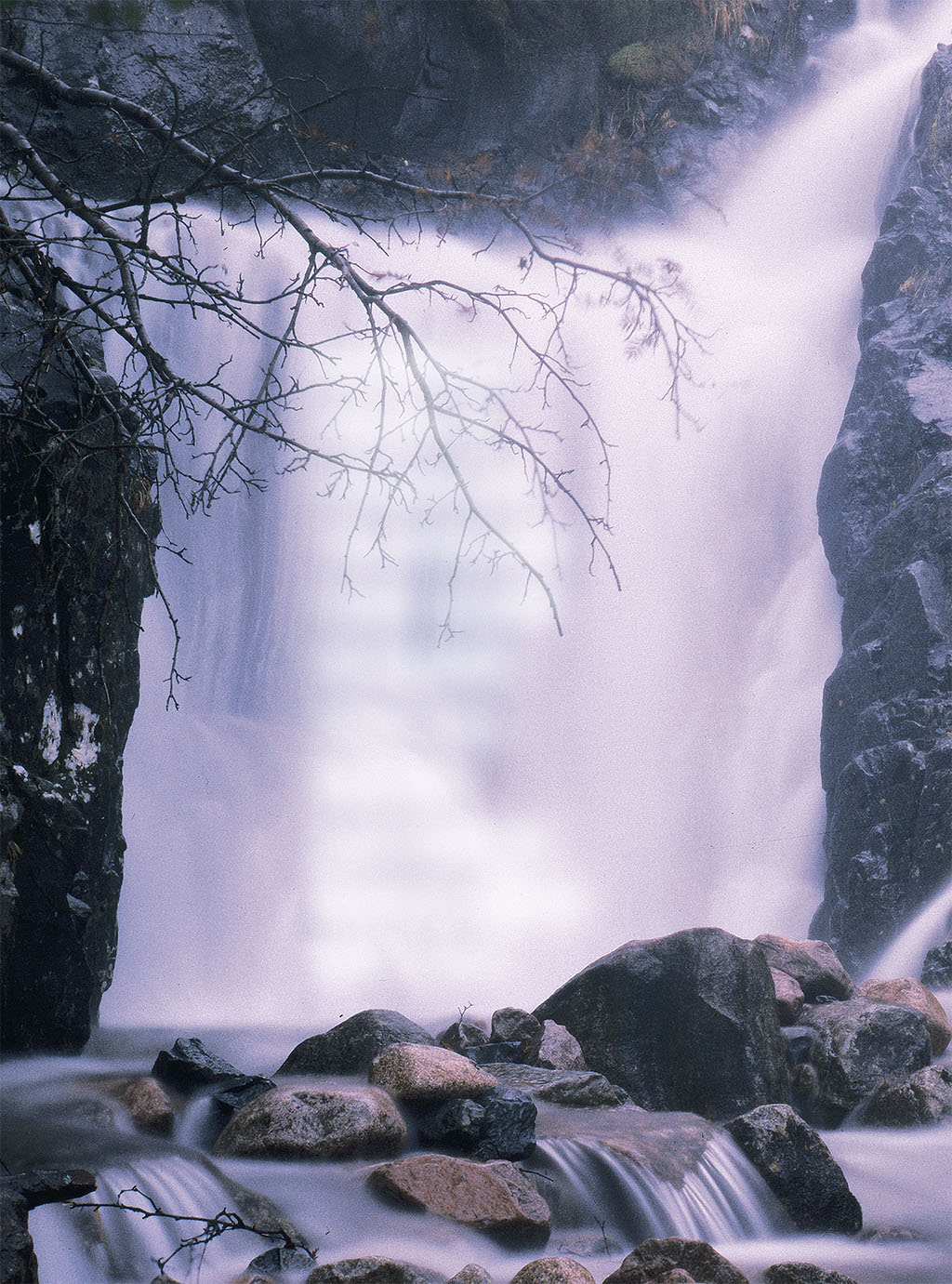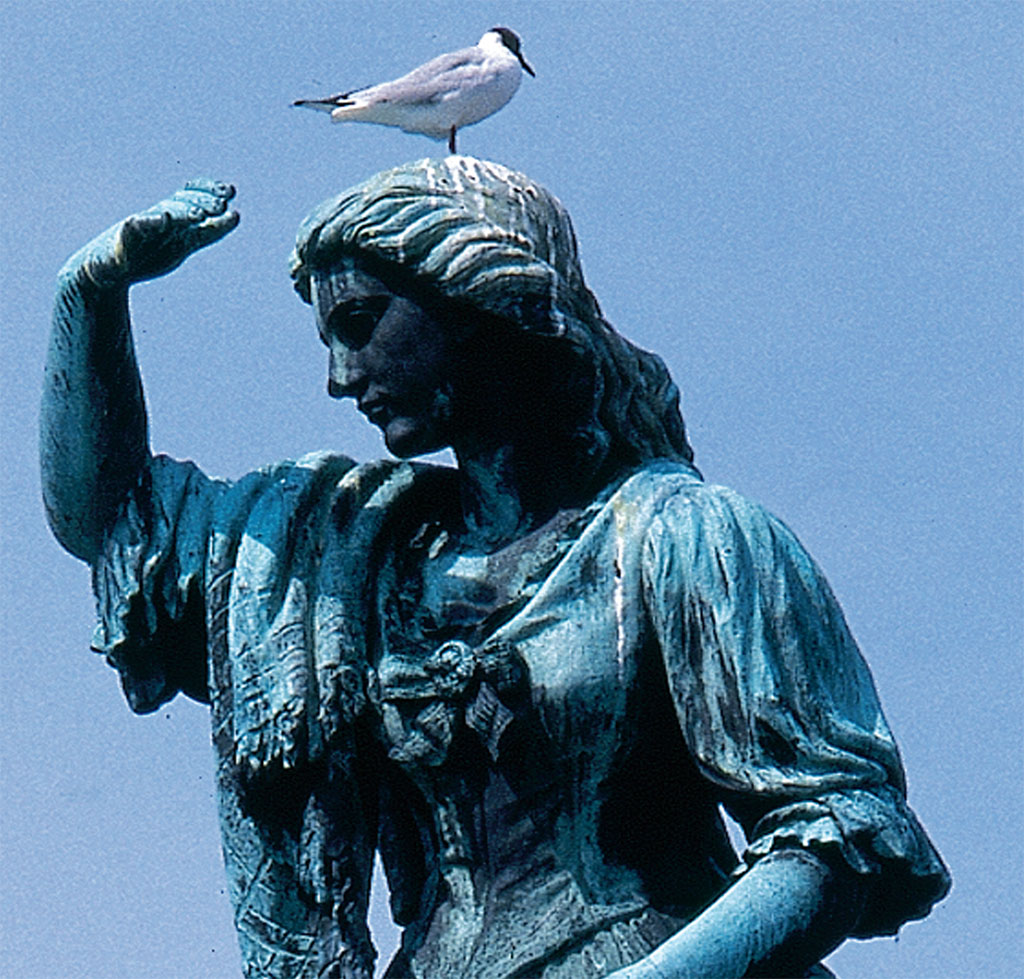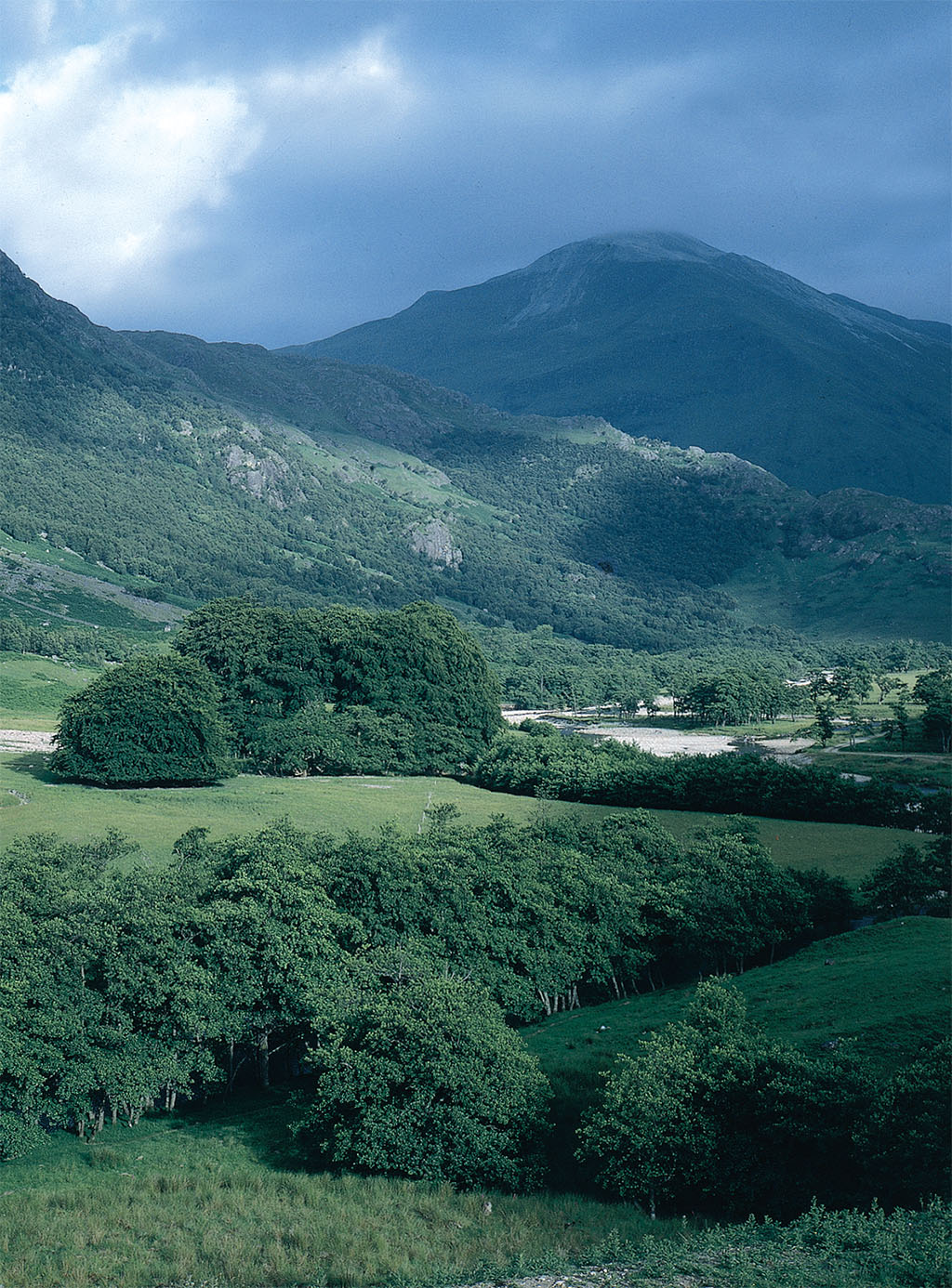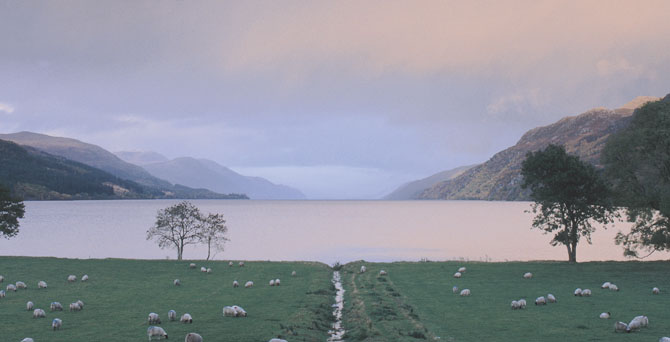
THE GREAT GLEN OF SCOTLAND
[caption id="OfLochsandLegends_Feature" align="aligncenter" width="929"]

STORIES and legends of Scotland’s Highland glens embroider a rich tapestry of fertile valleys, sunlit rocky slopes, mist-shrouded lochs, cloud-covered peaks and inhabitants who retain old-world traditions. If only one of Scotland’s valleys could be visited to savor as much as possible of the countryside’s vast diversity, it would have to be the Great Glen. Located along a fault line formed by upheaval between plates of the earth’s crust more than 350 million years ago and further eroded by the glacial Ice Age, the Great Glen stretches diagonally across the Highlands to connect the North Sea with the Atlantic Ocean via the searoads of Loch Linnhe and the Moray Firth.
Long one of the major routes through the country, the glen has featured prominently in many milestones of Scottish history. Along here in 1307 Robert the Bruce marched his army against the Comyns and their allies—the powerful Scottish opponents he had to subjugate before proclaiming himself king and leading his country to independence. During the ill-fated Jacobite Rebellion of 1745, Bonnie Prince Charlie made his escape through the glen after his defeat at Culloden.
[caption id="OfLochsandLegends_img1" align="aligncenter" width="707"]

BONNIE PRINCE CHARLIE TRAVELED THE GLEN DURING THE ILL-FATED JACOBITE REBELLION OF 1745.
Such an important thoroughfare has benefited from contemporary technological advances. General George Wade’s progressive military road-building program, implemented after the first Jacobite Rebellion of 1715, has been tested by the demands of the automotive society, and subsequent roads have been built over much of the original route, a testimony to Wade’s surveying talents. Thomas Telford’s impressive Caledonian Canal, completed in 1822 to join the sea roads and the three natural lochs, has stood the test of time. The traffic today is probably greater than even Telford could have envisaged, due to its popularity as a location for boating holidays.
At the northern end of the glen lies Inverness, proclaimed the “Capital of the Highlands” by Samuel Johnson during his journey to the Hebrides. With riverside pubs, shopping centers and industrial developments, the town has an air of recent prosperity, but there are interesting old buildings as well: Abertarff House, built in 1593, and the beautiful Gothic-style Town House, built in 1878. The latter gained a unique place in history in 1921 when it hosted the first Cabinet meeting to be held outside London, with Prime Minister David Lloyd George, Colonial Secretary Winston Churchill and Secretary of the Board of Trade Stanley Baldwin in attendance. The 19th-century Inverness Castle dominates the town; it replaced the 12thcentury castle built by David I when he made the town a royal burgh. On the forecourt of the present castle stands a statue of the Scottish heroine Flora MacDonald gazing wistfully toward her beloved Outer Hebrides. To the east once stood the castle where Shakespeare’s Macbeth murdered Duncan. This was actually the bard’s artistic license—the murder took place elsewhere—however, the castle was razed by Malcolm Canmore to avenge Duncan’s death.
The main road (A82) down the glen toward Fort William passes a cemetery on the outskirts of the town, which lays claim to being the most beautiful place to be buried in Britain. This steep conical hill called Tomnahurich, or Hill of the Fairies, is reputedly the doorway to the fairy kingdom through which two minstrels wandered by mistake one night. Awaking the following morning, they found the town had changed beyond recognition because the fairy night had actually been 100 years long. The next time they went to sleep, they crumbled into dust.
The road meanders down the west shore of Loch Ness, the largest stretch of inland water in the British Isles. More than 22 miles long and a mile wide, it’s also deep enough to swallow the Empire State Building. Loch Ness is famous worldwide because of its monster, affectionately known as Nessie and first sighted by St. Columba, who allegedly scolded the monster for attempting to eat one of his followers. In 1933 construction of the A82 seemed to awaken Nessie, because since then sightings have become regular. Is Nessie mythical or real? Even the countless scientific expeditions with high-tech gadgetry to scour the darkest depths have failed to conclusively answer the question. The legend makes a fascinating pastime, though, for tourists who have contributed countless funds to the economy of the area. The phenomenon is excellently documented in sound, animation and laser graphics at the Drumnadrochit Exhibition Centre.
[caption id="OfLochsandLegends_img2" align="aligncenter" width="1024"]

Set on a nearby promontory overlooking Loch Ness are the impressive ruins of Urquhart Castle, whose strategic position in the glen eventually made it the largest stronghold in Scotland. It suffered many turbulent times and changes of ownership between the first 12th-century fortification and its destruction in 1692, and today the castle ruins present a dramatic picture enhanced by the claim that it protects the subterranean lair of Nessie. A couple of miles farther along the road, a cairn stands as a poignant memorial to the heroes of the golden era of speed records, who gambled their lives for the accolade of being the fastest on land or water. The plaque records that John Cobb made the ultimate sacrifice pursuing the record there in 1952, when his boat disintegrated after hitting a mysterious object in the water (see “Timeline,º May 2005 issue).
[caption id="OfLochsandLegends_img3" align="aligncenter" width="1024"]

The road wending along the east shore is slower, less crowded and affords better views. From here the great literary travelers Samuel Johnson, James Boswell and John Keats recorded their impressions of Loch Ness. Halfway along the lake, a solemn graveyard perches precariously at the water’s edge. Opposite is a place once regarded as the most evil in Britain. When Boleskine House was owned by Aleister Crowley, self-styled chief emissary of the devil, he presided over satanic ceremonies there. Farther along, at the village of Foyers, a short, steep path leads to a waterfall immortalized in verse by Robert Burns:
Among the healthy hills and ragged woods
The roaring Fyers pours his mossy floods;
Till full he dashes on the rocky mounds,
Where, thro’ a shapeless breach, his stream resounds.
[caption id="OfLochsandLegends_img4" align="aligncenter" width="1024"]

LITERARY TRAVELERS LIKE JOHNSON, BOSWELL AND KEATS RECORDED THEIR IMPRESSIONS OF LOCH NESS.
Although subsequent diversion to produce hydroelectricity means the volume of water pouring over the falls is not what it was in Burns’time, it is still a dramatic, noisy spectacle.
At the south end of the loch, the roads meet at Fort Augustus, named after George II’s 8-year-old son in 1792, when a fort was built there. The remains of the fort were later given to Benedictine monks who incorporated them into the ground floor of the abbey and public school they founded. Apparently the monks were blissfully unaware of the true value of their treasures until two grimy pictures they offered for sale at a pittance were revealed to be paintings by the great J.M.W. Turner. The series of locks around which the village is centered mark the beginning of the canal leading to Loch Oich.
It’s worth stopping at the Bridge of Oich to wander across the fine pedestrianonly suspension bridge built in 1854 to replace the stone one washed away by violent floods five years earlier. Along the loch are the remains of the castle where the fugitive Bonnie Prince Charlie sought refuge. In a little bay just before the loch funnels into another section of canal is the particularly gruesome monument of Tobar nan Ceann, or Well of the Seven Heads. Beneath the obelisk with bronze heads, a damp tunnel leads to the sinister well itself. Here in 1663, poet Iain MacDonell washed the seven severed heads of the assassins of his clan chief Alasdair, before presenting them to MacDonell of Glengarry, who had refused to help him avenge the murder.
[caption id="OfLochsandLegends_img5" align="aligncenter" width="1024"]

At nearby Laggan Locks, a particularly ferocious clan fight between the Frasers and MacDonalds took place in 1544, which became known as Blar-na-leine, or Battle of the Shirts, because the men discarded their cumbersome plaids in the intense heat. Only 12 of the more than 1,000 men who met that day survived; the casualties included the entire Fraser hierarchy. This left the clan leaderless, though only temporarily, because 80 of their wives were pregnant and each reputedly gave birth to a male heir.
Farther along the shore of Loch Lochy, the road rises to a magnificent viewpoint above Spean Bridge crowned by the Commando Memorial. Commemorating those elite combat troops who fought so savagely during World War II, this bronze group of figures looks out over the harsh terrain that served as their training ground. Past Spean Bridge on a side road is Highbridge, scene of a skirmish between two companies of Royal Scots Guards and 10 clansmen just prior to the ‘45 Jacobite Rebellion. The Highlanders made so much noise with their swords, shields and bagpipes that the English were convinced they confronted a mighty army and they ran when ambushed. This victory persuaded many of the undecided to join the Rising and is celebrated by the pibroch “The Rout of the Lowland Captain.” A trail through the forest leads to the remains of the Wade Bridge, where the action took plac.
[caption id="OfLochsandLegends_img6" align="aligncenter" width="1024"]

In its last few miles, the glen plays host to some of the most dramatic mountains in Scotland, including Aonach Mor, the largest winter sports center in the country. In summer a gondola ride provides an effortless climb to over 2,000 feet, a lazy way to appreciate the stunning views. Ben Nevis, the British Isles’ highest peak, marks the end of the glen and, for those intrepid enough, the north face of the mountain provides an exhilarating and dangerous rock climb. There are safer ways to reach the top, however, along one of several routes suitable for walkers, which enables even the most inexperienced to climb to the summit with its ruins of an early weather observatory and hotel. However, extreme care must always be taken because the plateau can be enveloped in a blizzard even at the height of summer. For the less adventurous there are other explorations to be made at its base.
Glen Nevis is reputedly the finest example of a glacial valley anywhere in the world. Its splendid waterfalls and beautiful scenery inspired Hollywood moguls to use it as the location for the film Braveheart. At Banavie, Telford’s most ambitious and impressive section of the Caledonian Canal can be observed at close quarters, as boats negotiate Neptune’s Staircase, a series of eight locks dropping the waterway 64 feet to sea level in under a mile.
Fort William, nestled beneath the bulk of the ben, marks the end of the glen. Although the fort it was named after no longer exists, the community has flourished over the years due to various industries like aluminum production, fishing, farming and tourism. It offers a wide range of excellent accommodations, fine shops, award-winning restaurants, recreational activities and culturally oriented attractions.
The glen holds an indescribable appeal and exudes magic. You never tire of the stunning scenery or the pleasure of basking under blue skies just after fleeing torrential storms. Each visit uncovers another of its wonderful secrets. This truly is the Great Glen of Scotland.
[caption id="OfLochsandLegends_img7" align="aligncenter" width="871"]

TOURIST INFORMATION OFFICES
INVERNESS—CASTLE WYND,IV23 BJ, Phone: 01463 234353, Fax: 01463 710609
FORT AUGUSTUS—CAR PARK,PH32
4DD, Phone: 01320 366367, Fax: 01320 366779
FORT WILLIAM—CAMERON SQUARE,
PH33 6AJ, Phone: 01397 703781, Fax: 01397 705184
PLACES TO VISIT
DRUMNADROCHIT: THE OFFICIAL LOCH NESS MONSTER EXHIBITION CENTRE. Audiovisual presentations and display of equipment used by monsterseekers. ’Tis all ye know on earth of Nessie, and all ye need to know.
FORT WILLIAM WEST HIGHLAND MUSEUM, Cameron Square. This museum covers all aspects of West Highland life and has some superb curios from the Jacobite Rebellion. Open all year.
TREASURES OF THE EARTH,ROAD TO THE ISLES, Corpach. Set in simulated caves, the collection of crystals, gemstones and fossils is thought to be the largest of its kind in the British Isles.
THE GREAT GLEN CLAN CAMERON MUSEUM, Achnacarry, Spean Bridge. Home of Cameron of Lochiel, exhibits illustrate the history of the clan and their involvement in the ’45 Jacobite Rebellion. Additional displays about the Queens Own Cameron Highlanders and the Commandos who trained there during World War II. Open Easter through October.
NEVIS RANGE CABLE CARS, Torlundy, by Fort William. Gondola rides up are offered the mountain to a restaurant and marked walks along the range. There are gift shops and a cafe at the ground station, with marked forest walks, nature trails and cycle tracks. Open Christmas through October.





Comments